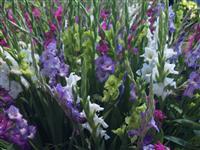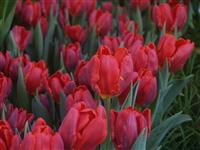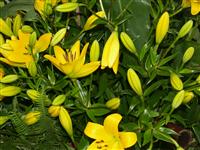Learn how to grow your own flowers from bulbs.
- Have you always wanted to know more about growing your own flowers from bulbs?
- Would you like to do it commercially?
 With this course:-
With this course:-
- Develop your ability to select and cultivate appropriate varieties of bulbs as cut flowers (in different situations).
- Identify bulbs and the families they belong to and to determine their cultural needs.
- Form a sound understanding of the basis of horticultural practice: soil types, plant nutritional needs, treating and preventing pests, diseases and weeds.
- Course Duration: 100 hours of self paced study - start at any time and study at a pace to suit you.
This is a course designed for the flowering bulb enthusiast or commercial bulb grower for the cut flower market. There are ten lessons in this course with loads of practical skills to get you inspired and to get you growing! You will learn the basics of good horticultural management including: soil types, plant nutrition, pest and disease management, environmental management and also the various types of bulbs used for cut flower production. If you have always wanted to learn more about flowering bulbs and how to grow them commercially or at home, this is the place to start!
“Everyone loves getting a bunch of flowers – bulb growing for the cut flower trade can be a rewarding career; this course will equip you with the skills and knowledge to forge a career in this field.”-- Jacinda Cole B.Sc., Psych. Cert., Cert. Garden Design, MACA, ACS Tutor
Course Content
There are 10 lessons in this course:
1. Introduction to Cut Flower Bulb Production
- Overview of floriculture
- Information on flower structure
- How plants grow
- Specialised vegetative structure
- Introduction to hydroponics
- Classification of hydroponic systems
2. Cultural Practices
- Understanding soil composition, structure and texture
- Ways to improve soil
- Importance and types of soil water
- Soil pH
- Nutrient availability and pH
- Soil and plant tissue analysis
- Soil degradation and rehabilitation (erosion, salinity, acidification etc)
- The nutrient elements (major and minor)
- Diagnosing nutritional problems
- Fertilisers (types, application, etc)
- Natural fertilisers
- Fertiliser selection
- Weed control methods
3. Flower Initiation & Development
- Encouraging plants to flower out of season
- Ways to cause controlled flowering
- How to modify plant environment
- Photosynthesis
- Carbon dioxide enrichment
- Response of plants to CO2
- General guidelines of planting bulbs
- Mulching
- Soil mixes and potting media
4. Pest & Disease Control
- Law in relation to chemical used
- Disease identification and management in bulb crops
- Plant viruses detection and diagnosis
- Pest identification and management in bulb crops
- Environmental Problems and their treatment
5. Managing Yield, Greenhouse Culture
- Greenhouse growing system
- Components of greenhouse facility
- Types of greenhouse
- Commonly used greenhouse designs
- Shade houses
- Greenhouse benches and beds
- Environmental control in greenhouses
- Measurements of environmental factors
- Heating, cooling and ventilation systems
- Lighting
- Horticultural management in a greenhouse (pest and disease, irrigation etc)
- Plant and water relation
- Growing bulbs in open ground
- Irrigating field grown bulbs
- Types of irrigation system
6. Management, Harvest & Post Harvest
- Managing market gardens
- Factors in Deciding Which Plants to Grow
- Production and crop scheduling
- Cost efficiency standards
- Quality and quantity standards
- Farm layout (design of a store)
- Marketing bulb crops
- The marketing process (supply and demand, market research etc)
- Aging in cut flowers
- Factors affecting the longevity of cut flowers
7. Gladiolus and Liliums
- Classification of liliums and gladiolus
- Growing conditions
- Soil and nutrition
- Planting and propagation
- Pest and diseases
- Harvest and post-harvest
8. Narcissus
- Classification of narcissus
- Growing conditions
- Soil and nutrition
- Planting and propagation
- Pest and diseases
- Harvest and post-harvest
9. Iris
- Classification of Iris
- Growing conditions
- Soil and nutrition
- Planting and propagation
- Pest and diseases
- Harvest and post-harvest
10. Other Bulbs
- Scented bulbs
- Alstroemeria
- Amaryllis
- Dahlia
- Freesia
- Hyacinth
- Ranunculus
- Orchids
- Ways of judging flower quality
In each lesson there are set tasks to complete based on practical skills and problem based learning. There is also an assignment to complete with each lesson. The assignment will be marked by your tutor and returned to you with their comments and recommendations.
AIMS
 Describe cultural practices for production of different cut flower bulbs, including the basis of all good horticultural practices.
Describe cultural practices for production of different cut flower bulbs, including the basis of all good horticultural practices.- Develop an understanding of soils, plant nutrition, and weed control.
- Understand the initiation and development of flowers in plants with bulbs, rhizomes, tubers, corms or other specialized parts. Look at the factors affecting the flowering stages.
- Learn how to manage any pests and diseases for a crop of cut flower bulbs or in the home garden.
- Manage the quantity and quality of a crop of cut flower bulbs, both grown in the open and in a greenhouse. In this lesson we also have a good look at the various systems of growing cut flower bulbs in greenhouses and look at ways to manage the environmental conditions in them.
- Learn about the management and the harvest/post harvest of cut flower bulbs.
- Explain the production of Lilium and Gladioli cut flower crops.
- Explain the production of Narcissus cut flower crops.
- Explain the production of Iris and Gladioli cut flower crops.
- Learn to compare different cut flower bulb crops.
Floriculture: An Overview
Floriculture enriches the lives of millions of people every year and is an industry attractive to both scientist and artist. The term 'floriculture' is derived from Latin, and means 'to cultivate flowers'. Flowers are in demand all year round with peak requirements at special times of the year, such as for Valentine’s Day, Mother’s Day, Easter, Christmas, and so on. Particular festivals often influence the type of flowers required e.g. red roses for Valentine’s Day.
Floriculture businesses produce fresh and dried flowers and foliage for a mixture of markets such as wholesale flower markets, florists and retail outlets, and in some cases for export. The wide range of different flowers and foliage grown can include roses, carnations, orchids, native flowers, bulb and annual flowers, and tropical flowers. Some flower farms also grow flowers in open fields for their essential oils.
Floriculture includes propagating, growing and marketing of all cut flowers, flower seeds and seedlings, bulb growing, nursery operation, chemical protection of plants, post-harvest storage and handling and use of preservatives.
A proportion of flower production takes place in greenhouses. In addition to the greenhouse production, floriculture encompasses outdoor production of herbaceous plants and flowers, and field production of cut flowers.
The International Flower Market
 Cut flower production is an expanding industry worldwide. It has a great deal of export potential, and although most flower producing countries meet the domestic requirements of their cut flower markets, the home market potential in many countries could be further developed. Spending on cut flowers is stronger in some countries than others, the average expenditure in Australia for example is far less on cut flowers than may be seen in some European countries).
Cut flower production is an expanding industry worldwide. It has a great deal of export potential, and although most flower producing countries meet the domestic requirements of their cut flower markets, the home market potential in many countries could be further developed. Spending on cut flowers is stronger in some countries than others, the average expenditure in Australia for example is far less on cut flowers than may be seen in some European countries).
Germany imports most of their cut flower requirements (up to 70%) with the Netherlands being the largest exporter to Germany. Japan and the United States have the largest cut flower market almost doubling that of Germany.
During the later part of the 20th century, cut flower production developed rapidly. Colombia, Israel and to a lesser degree, Australia, developed export cut flower industries rapidly during this period with China and India having the largest areas under cultivation (but low yields per hectare).
The Netherlands has been, and continues to be a major export market that also has a large domestic demand, the local demand almost equalling exports. Countries such as India and China although having large production areas are still in the developing stage mainly due to the low quality of exports and the financial constraints limiting imports. Colombia and Kenya export most of the cut flowers produced with only a small local market.
Being in the southern hemisphere means that some countries (for example Australia, South Africa, New Zealand) are able to produce out of season flowers for the northern hemisphere where most of the world's population resides.
Opportunities from this course to gain or create employment include:
- Farming or cut flower bulb production.
- Greenhouse management of cut flower bulb production.
- Managing the production of cut flower bulbs for the commercial market.
- Maintenance of flowering bulbs in garden displays.
Why Study with ACS?
Design your own learning pathway.
Study at your own pace, from anywhere, at any time.
Receive prompt, expert support from our team of committed and friendly tutors.
Your learning is our priority. We are flexible and adaptable to meet your educational needs!
Enrolling is easy - just go to the top of this page and select your study method and payment option.
If you have any questions about studying with ACS, or want to know more about any of our courses, get in touch with our specialist tutors today. They will be happy to answer your questions and look at different study options to fit in with your goals.